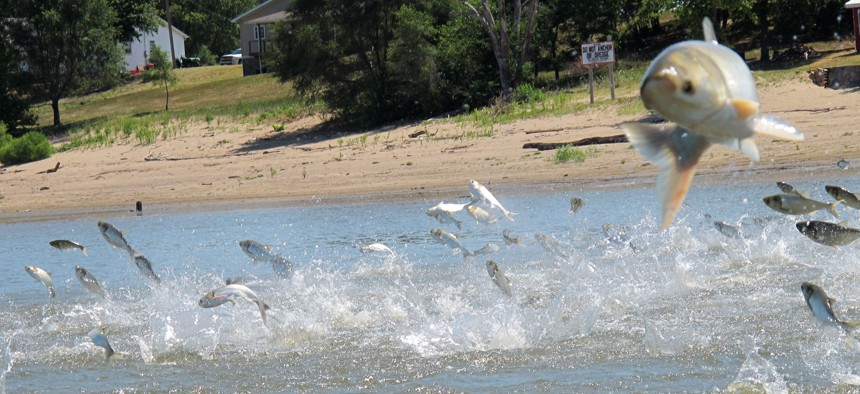Could a New Michigan Competition Prevent the Next Big Great Lakes Invader?

In this June 13, 2012 file photo, Asian carp, jolted by an electric current from a research boat, jump from the Illinois River near Havana, Ill. John Flesher / AP File Photo
Invasive species like zebra mussels threaten the Great Lakes ecosystem. Now, a statewide competition will award creative solutions for keeping other invaders at bay.
While growing up, during visits to my family’s summer house near Sturgeon Bay, Wisconsin, the shoreline of Lake Michigan was dotted with stones and plants, intermingled with fossils of shells and coral that hearken back to the prehistoric history of this region.
Now, most of those rocks, plants and fossils are buried under miles-long mounds made of zebra mussel shells, bleached white by the sun.
The problem posed by these mussels is more than just a question of aesthetics. These creatures are adept at water filtration and over the years they have dramatically increased water clarity in the Great Lakes—only Lake Superior remains relatively immune due to low calcium deposits. As a result, more sunlight is able to penetrate, and penetrates deeper, a catalyst for algae growth . When this algae washes ashore and decomposes, it promotes the growth of bacteria dangerous to humans and the lake’s wildlife.
Zebra mussels aren’t the only non-native species that pose a challenge to the lakes. The National Oceanic and Atmospheric Administration lists as many as 180 invasive and non-native species that threaten the Great Lakes ecosystem—quagga mussels, sea lamprey, alewife fish, asian carp and more.
In and around Chicago, a network of electrified barriers has taken shape in the waterways that connect Lake Michigan with the Illinois River to help keep invasive fish like Asian bighead and silver carp from gaining a foothold in the Great Lakes watershed . There’s also evidence of a different species of invasive carp in the Sandusky River in northwestern Ohio and also in the St. Lawrence River near Montreal, Quebec .
There are fears that the carp could bring more disruption to the Great Lakes ecosystem.
Great Lake states like Michigan have been trying to tackle this problem for a long time. The Michigan Invasive Species Grants Program was established in 2014 and has brought together the Departments of Natural Resources, Environmental Quality, Agriculture and Rural Development. In 2016, $3.6 million were made available in the state’s general budget to go toward “prevention, detection, eradication and control” of invasive species.
Now, Michigan Gov. Rick Snyder has taken preventative efforts even farther. On Thursday, Snyder chose to sign the state’s $55 billion budget for the coming fiscal year on the Lake Michigan shoreline, a gesture to call attention to a brand new budget item —a competition to come up with creative solutions to prevent invasive species in the Great Lakes with a $1 million grand prize.
The spread of the zebra mussel through the Great Lakes stands as a frightening example of how difficult it can be to control an invasive species once it gains a foothold—which means that prevention is by far the most cost-effective strategy.
By opening up this issue to a state-wide competition, Michigan may play a role in the creation of an innovative solution to a problem that has far-reaching consequences for the entire region.
RELATED: Watch the Michigan Department of Natural Resources Asian Carp training on the Illinois River in August 2015
Quinn Libson writes for Government Executive’s Route Fifty.
NEXT STORY: Upstate N.Y. Local Governments Get Infusion of Casino Money






